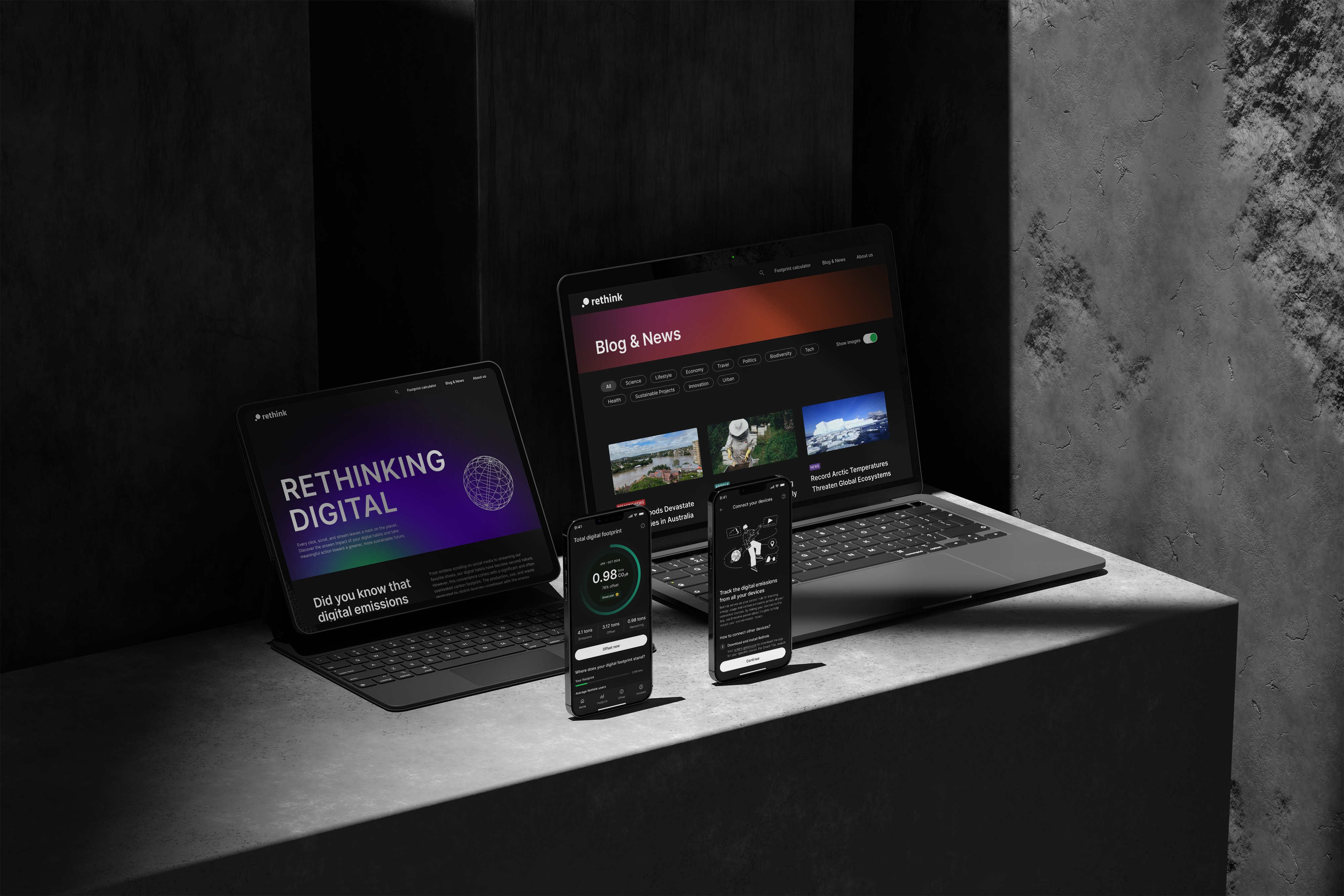Ester Xofra Mateo
Rethink
/24
The Challenge
The effects of climate change are increasingly evident, demanding urgent solutions. While many individuals have adopted sustainable habits, such as reducing plastic consumption or using cleaner fuels, the environmental impact of digital activities often remains invisible.
Activities like streaming, cloud storage, and AI-powered apps contribute significantly to energy consumption and carbon emissions, yet users rarely connect these actions to climate change. This lack of awareness is further compounded by the rapid evolution of powerful devices and the Internet, which often prioritize functionality over sustainability in their design.
For technical users, tools are needed to make digital emissions visible and actionable. Meanwhile, the general public benefits from solutions that encompass broader lifestyle habits while raising awareness about the connection between everyday actions and the environment.
Solution
Rethink bridges the gap between awareness and action, empowering users to understand, reduce, and offset their carbon footprint. The platform combines education with actionable features, making sustainability an achievable goal for everyone.
Visible Digital Impact: Break down emissions by activity, such as streaming, cloud storage, and AI-powered apps, helping users see the tangible impact of their digital habits.
Actionable Insights: Provide personalized tips to reduce emissions, such as optimizing cloud storage, adjusting streaming quality, or minimizing energy-intensive tasks.
Offset Opportunities: Offer options to balance emissions through activities like supporting renewable energy projects or participating in waste reduction initiatives.
Educational Resources: Equip users with knowledge about climate change and digital sustainability, inspiring them to take meaningful steps.
Sustainable Design: The app itself follows eco-friendly principles, including default dark mode, lightweight interfaces, and optimized server usage to reduce its own environmental footprint.
Design Process
The design process transitioned from a traditional user-centered approach to an environment-centered framework, broadening the focus to prioritize user needs and minimize environmental impact. This approach evaluated how functionality, interface, and technical elements could reduce energy consumption, lower carbon emissions, and promote eco-friendly behaviors.
Research Phase
The research began with a study of carbon footprint calculators and offset platforms, revealing a gap in addressing digital emissions. Benchmarking best practices for presenting complex data informed the creation of clear, user-friendly interfaces.
A survey of 73 participants and five in-depth interviews identified two distinct target audiences: technical users focused on detailed tracking and general users seeking broader sustainability solutions. These insights guided the development of two personas and a non-human persona inspired by Montserrat Mountain, aligning the design with ecological principles and ensuring a balanced approach between human and environmental needs.
Definition Phase
The definition phase focused on creating a sustainable structure for the app and website. User flows were designed to minimize unnecessary clicks, reducing server requests and their associated carbon emissions. Wireframes played a key role in streamlining each page to eliminate non-essential elements, ensuring a user-friendly and environmentally efficient product.
Design Phase
The design phase integrated usability and sustainability principles. Dark mode reduced energy consumption on OLED screens, while lightweight interfaces minimized server load. The visual identity combined earthy tones with digital accents to reflect the balance between technology and nature. High-fidelity prototypes underwent iterative testing, ensuring an intuitive, engaging, and eco-conscious final product.
Conclusions
Rethink was a pivotal project that redefined my approach to digital product design, marking my first experience with an environment-centered framework. Balancing user needs with sustainability goals challenged me to rethink efficiency, resource management, and the broader impact of design decisions.
One of the most significant challenges was simplifying complex data to educate users about the often-invisible environmental impact of digital habits while presenting actionable solutions. Designing user flows to reduce unnecessary interactions taught me how even small adjustments in usability can contribute to minimizing carbon emissions.
Exploring new concepts, such as the non-human persona inspired by Montserrat Mountain, helped ground the design in ecological principles and connect product features to environmental goals. Resources like The Green the Web and Sustainable Web Design expanded my understanding of how to create lightweight, energy-efficient digital products, which will inform my future projects.
This project also highlighted the importance of tailoring solutions for distinct audiences—technical users and the general public—while maintaining a cohesive vision. Rethink reinforced my belief in design as a tool for driving both awareness and action, showing that digital products can inspire meaningful change when thoughtfully crafted with both people and the planet in mind.





